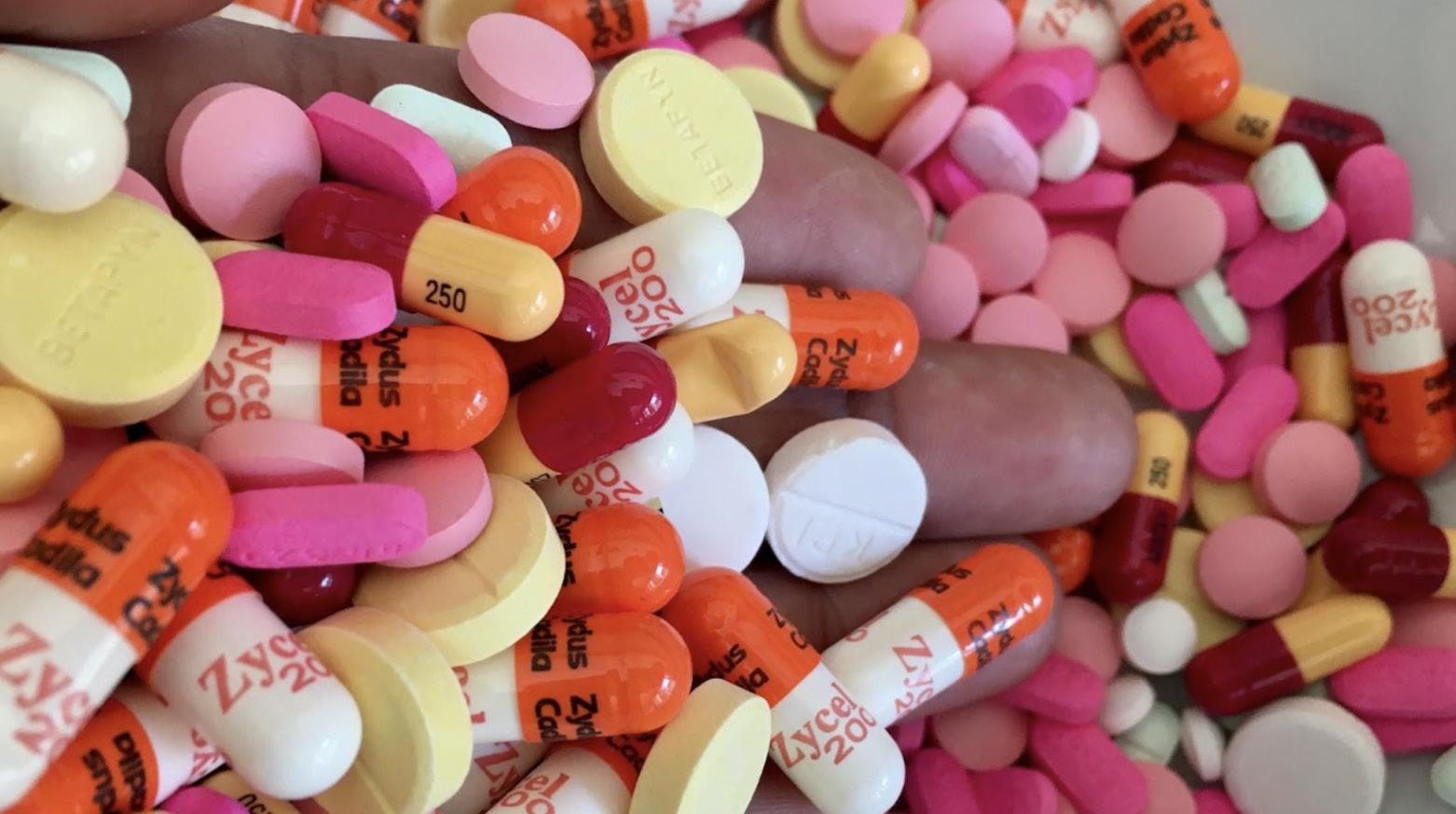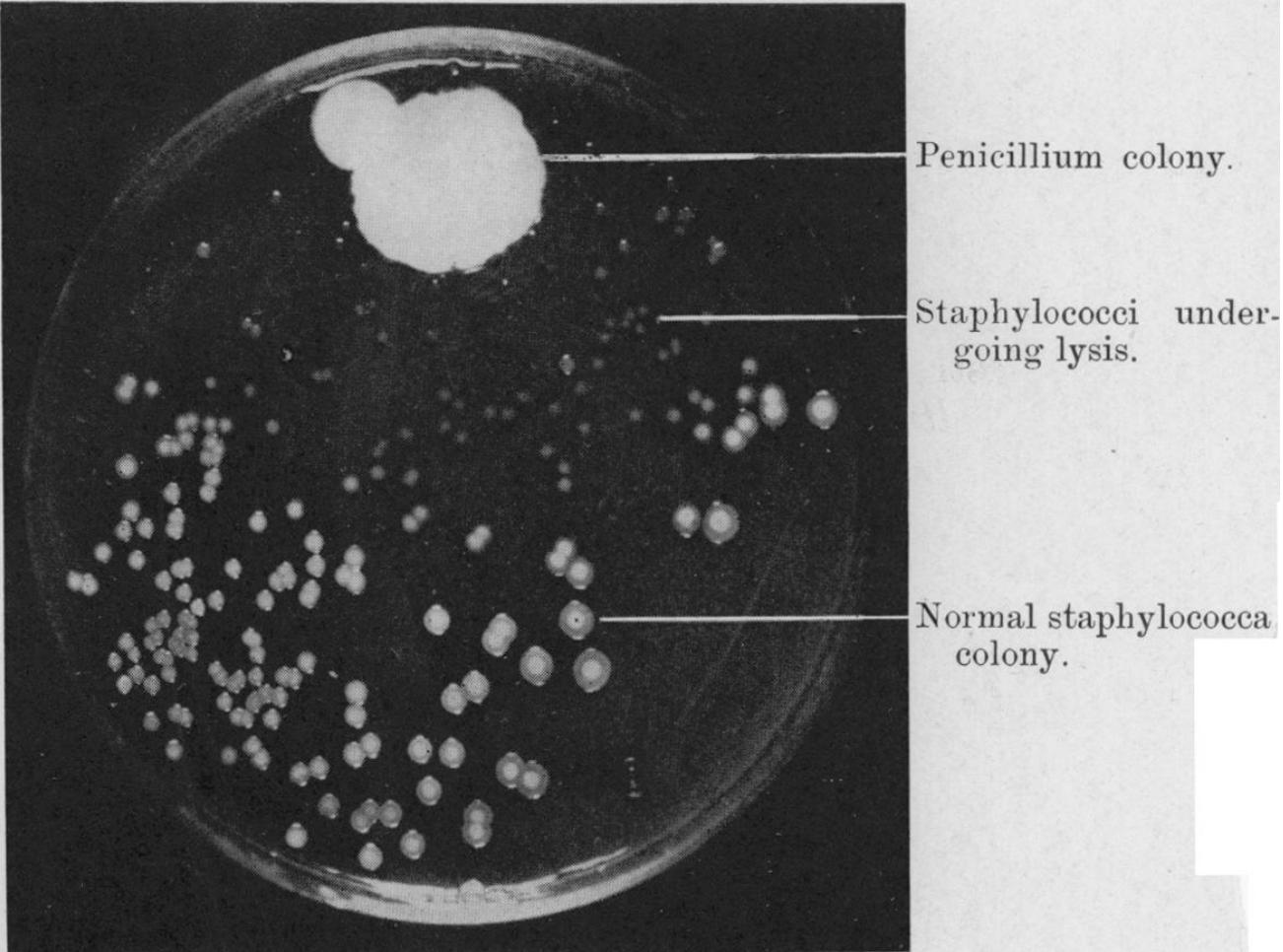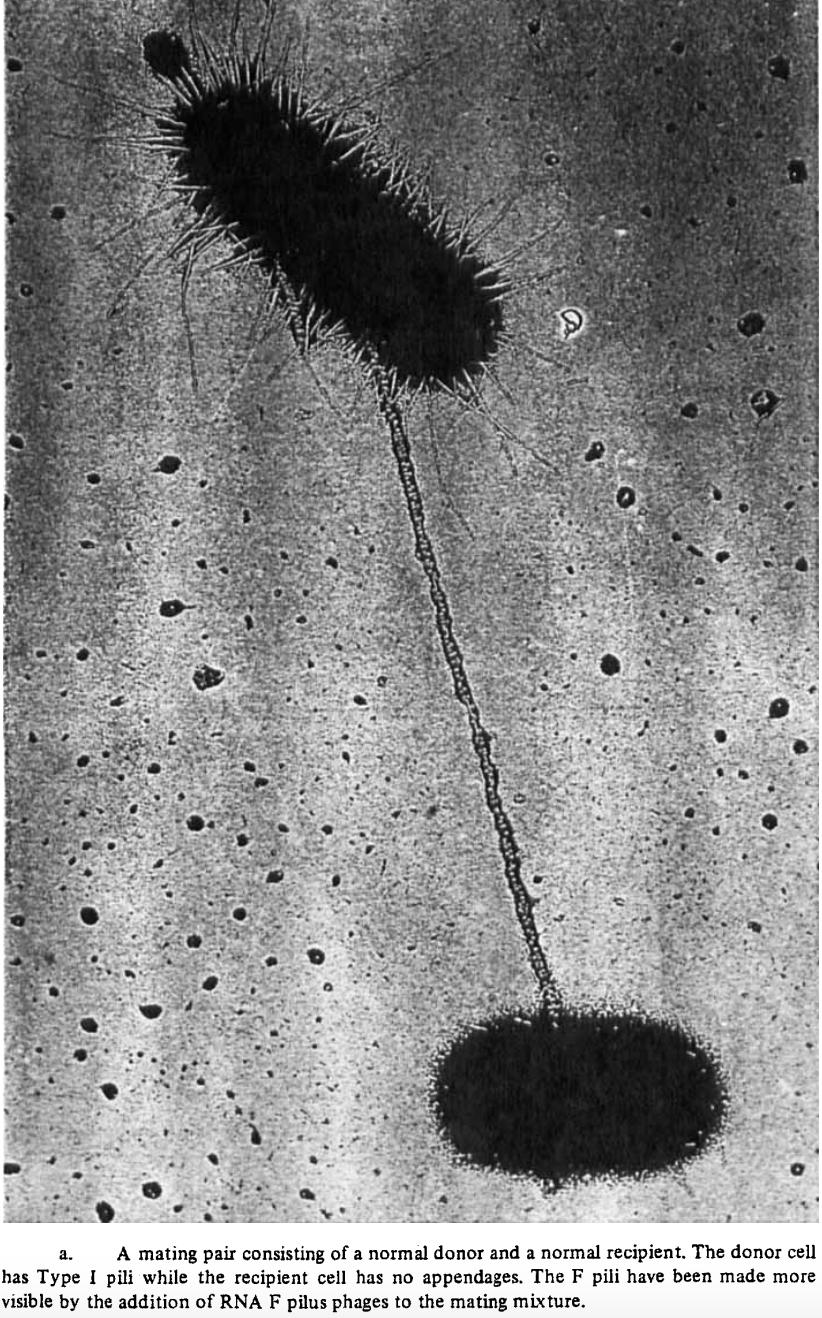
9 minute read
Antibiotic Resistance: A Silent Pandemic Merve Ozdemir
from Flux
Antibiotic Resistance: A Silent Pandemic
BY MERVE OZDEMIR
Advertisement
In 1928, in a London laboratory, Scottish bacteriologist Alexander Fleming looked into one of his culture plates, on which he was growing colonies of Staphylococcus, a genus of Gram positive bacteria that grows in grape-like clusters. To his surprise, he noticed a colony of contaminated mold around which the bacteria could not grow (Figure 1).1 Fleming had accidentally discovered a substance produced by the fungus Penicillium chrysogenum that was able to inhibit bacterial growth. The mystery substance had contaminated Fleming’s sample, killing off the bacteria and producing a clear, bacteria-free zone in the dish. Though Fleming could neither identify nor purify the substance at the time, he named it “penicillin.”2
It was only a decade later that scientists at Oxford University, Howard Florey, Ernst Chain, and Norman Heatley, succeeded in purifying penicillin and proposing it as a drug.3 In 1945, Florey and Chain were awarded the Nobel Prize together with Fleming. Shortly after, mass production of the antibiotic began.
While penicillin was the first antibiotic to be discovered, it certainly was not the last. Between 1940 and 1960, the period often called the “Golden Age of Discovery,” scientists discovered many more antibiotics, including those still commonly used like streptomycin, erythromycin and chloramphenicol.2 Today, antibiotics are one of the most commonly used medicines, prescribed to treat a variety of bacterial infections. They work by disrupting essential processes in the bacteria, which results in either their immediate death or arrest in replication.
But modern healthcare is facing a serious threat. After decades of treating patients with antibiotics, bacteria are learning to fight back, and our drugs are no longer the almighty killers they used to be. There are a number of bacterial strains that have developed resistance to one or more antibiotics, and resistance is spreading at a pace faster than new drug developments can keep up.
Currently, drug resistant infections kill around 700,000 people every year, and the United Nations estimates that the annual death toll could go up to 10 million by 2050, which would make drug resistant pathogens deadlier than cancer.4 “In essence,” proclaimed a 2013 editorial in Na-

Figure 1. Fleming’s photograph of a Staphylococcus culture plate with bacterial clearing around the penicillium colony.
ture, “we are engaged in an arms race with pathogenic bacteria — and we are losing.”5
The data points to a concerning possibility, where simple infections that are easily treated today could become, in the not-so-distant future, a death sentence.
HOW DID WE GET HERE?
When Fleming won the Nobel Prize in 1945, he warned the public of a concerning possibility. In his Nobel lecture, he explained, “The time may come when penicillin can be bought by anyone in the Studies have also shown that around 3060% of antibiotics prescribed in hospital intensive care units (ICUs) are “unnecessary,” “inappropriate,” or “suboptimal.”10
But extensive antibiotic prescriptions to patients is only part of the problem. Around 80% of antibiotics sold in the United States are used in livestock to prevent infections, improve the health of animals, and increase yields.11 The resistant bacteria that thrive in livestock under antibiotic pressure are then transferred to humans upon ingestion, where they can cause infection. Furthermore, the excretion of antibiotics from livestock via urine and stool cause the drugs to get mixed in soil and disperse through fertilizer and groundwater.12
So while humans did not create the biological phenomenon of antibiotic resistance, we certainly played a massive role in turning resistance into the large-scale threat it is today. The excessive use of antibiotics has created an evolutionary stress on bacterial populations, driving the development of resistance through positive selection for resistance genes.
shops. Then, there is the danger that the ignorant man may easily underdose himself, and by exposing his microbes to non-lethal quantities of the drug, make them resistant.”6 Fleming’s fear of resistance has certainly become a reality today, but it is important to ask nevertheless: how did we get here?
Contrary to popular belief, antibiotic resistance did not start with us. In the natural world, where bacteria compete with each other for limited resources, antibiotics have been bacteria’s biggest weapons against other bacteria. Thus, antibiotics have existed in nature even before humans started using them clinically, evolving slowly through natural processes.
But the current rate at which resistance is evolving is much faster than natural evolution, making it almost impossible for us to catch up.7 What is causing resistance to evolve so quickly? In a way, humans are.
Millions of pounds of antibiotics are used each year, but the usage of these drugs is poorly regulated. In 2020, the CDC reported that healthcare providers have prescribed 201.9 million antibiotic prescriptions.8 According to another report, at least 28% of annual prescriptions in outpatient settings were completely unnecessary.9 HORIZONTAL GENE TRANSFER

Figure 2. Conjugation pilus between donor and recipient bacteria.
One way that bacteria speed up the evolution of drug resistance is through a process called horizontal gene transfer (HGT), the exchange of genetic material between non-genetically related bacteria. Similar to how humans pass on genes to their offspring (vertical gene transfer), bacteria can exchange segments of DNA between each other without needing to have a parent-offspring relationship.
Genes conferring resistance can spread among different bacterial species through HGT. In the presence of antibiotics, the spread of resistance is so favorable for survival that some bacteria even actively kill their neighbors to speed up the process of horizontal gene transfer.7
Genes can be transferred horizontally through three mechanisms: conjugation, transformation, and transduction. Transformation is the process in which free, “naked” DNA from the environment is incorporated into the genome of a bacteria. Transduction is similar but requires mediation by a bacteriophage, a special type of virus that infects bacteria. Genes from the host bacterium are carried in the genome of the bacteriophage, then incorporated into the recipient bacterium upon phage infection.13 Conjugation, unlike transformation and transduction, requires physical contact. It occurs through a conjugation “pilus,” a bridge-like structure through which genetic material is transferred from the donor to the recipient (Figure 2).14
WHAT’S NEXT?
Unfortunately, little progress is being made to overcome the antibiotic resistance crisis. The development of new, effective antibiotics is incredibly slow, mostly due to economic barriers. Developing an antibiotic is costly, and the revenue from selling the drug is relatively low. For pharmaceutical companies, investing in this area of research is simply not profitable. Many companies have left the search for new drugs and have instead moved on to more profitable areas like cancer therapeutics.4
Healthcare workers, policy makers, governments, and even economists have been slow to act. Despite the enormity of the threat, its gradual development over time compared to more sudden crises like the COVID-19 pandemic has led people to underestimate the urgency of the problem.
But hope remains. Hospital-based antibiotic use can be improved with stewardship programs, and patients can be better educated about the importance of taking antibiotics in the correct dose and duration throughout their treatment. Similarly, public education about when and why antibiotics are necessary is essential. For example, antibiotics are useless against viral infections, because viruses have a significantly different structure than bacteria, rendering them resistant to the action mechanism of antibiotics. Preventative measures like hygienic practices can also be taken by individuals to limit the risk of infections in the first place. Antibiotic usage in agriculture and livestock must be better regulated, taking into account the long-term effects of these drugs on the environment and human health.15
CONCLUSION
The problem of antibiotic resistance seems to be growing at an alarming rate. Though the numbers are certainly cause for alarm, we can come back from this. Bacteria are diverse and sophisticated, yet they only want two simple things: to survive and to replicate. It is our actions that disrupted the balance and forced them to wage war on us. It is not too late to reestablish peace. Public education, better policies, collective action and a detailed understanding of the mechanisms behind resistance is our biggest chance. This is just the beginning.
REFERENCES
1. Fleming, A. (1929). On the antibacterial action of cultures of a penicillium, with special reference to their use in the isolation of
B. influenzae. British journal of experimental pathology, 10(3), 226. 2. Gaynes R. (2017). The Discoveryof penicillin—new insights after more than 75 years of clinical use.
Emerging Infectious Diseases, 23(5), 849–853. https://doi.org/10.3201/ eid2305.161556 3. Chain, E., Florey, H. W., Gardner,
A. D., Heatley, N. G., Jennings,
M. A., Orr-Ewing, J., & Sanders,
A. G. (1940). Penicillin as a chemotherapeutic agent. The lancet, 236(6104), 226-228. 4. Plackett, B. (2020). Nature, 586, 5053. 5. The antibiotic alarm. (2013).
Nature,495(7440), 141–141. https:// doi.org/10.1038/495141a 6. Fleming, A. (1942). Nobel Lecture,
December 11, 1945. Nobel Lectures,
Physiology or Medicine, 1962, 83–93. 7. Cooper, R. M., Tsimring, L., & Hasty,
J. (n.d.). Inter-species population dynamics enhance microbial horizontal gene transfer and spread of antibiotic resistance. ELife, 6, e25950. https://doi.org/10.7554/eLife.25950 8. Center for Disease Control &
Prevention (CDC). Outpatient
Antibiotic Prescriptions—United
States, 2020. (n.d.). 5. 9. Center for Disease Control &
Prevention (CDC). Measuring
Outpatient Antibiotic Prescribing. (2021, October 12). https://www.cdc. gov/antibiotic-use/data/outpatientprescribing/index.html 10. Luyt, C.-E., Bréchot, N., Trouillet,
J.-L., & Chastre, J. (2014). Antibiotic
stewardship in the intensive care unit.
Critical Care, 18(5), 480. https://doi. org/10.1186/s13054-014-0480-6 11. Spellberg, B., & Gilbert, D. N. (2014). The future of antibiotics and resistance: a tribute to a career of leadership by John Bartlett. Clinical
Infectious Diseases: An Official
Publication of the Infectious Diseases
Society of America, 59(Suppl 2),
S71–S75. https://doi.org/10.1093/cid/ ciu392 12. Ventola, C. L. (2015). The antibiotic resistance crisis. Pharmacy and
Therapeutics, 40(4), 277–283. 13. Soucy, S. M., Huang, J., & Gogarten,
J. P. (2015). Horizontal gene transfer: building the web of life. Nature
Reviews Genetics, 16(8), 472–482. https://doi.org/10.1038/nrg3962 14. Brinton, C. C. (1971). The properties of sex pili, the viral nature of
“conjugal” genetic transfer systems, and some possible approaches to the control of bacterial drug resistance. CRC Critical Reviews in
Microbiology, 1(1), 105–160. https:// doi.org/10.3109/10408417109104479 15. Bartlett, J. G., Gilbert, D. N., &
Spellberg, B. (2013). Seven ways to preserve the miracle of antibiotics.
Clinical Infectious Diseases, 56(10), 1445–1450. https://doi.org/10.1093/ cid/cit070
IMAGE REFERENCES
1. Figure 1: Fleming, A. (1929). On the antibacterial action of cultures of a penicillium, with special reference to their use in the isolation of
B. influenzae. British journal of experimental pathology, 10(3), 226 2. Figure 2: Brinton, C. C. (1971). The properties of sex pili, the viral nature of “conjugal” genetic transfer systems, and some possible approaches to the control of bacterial drug resistance. CRC Critical Reviews in
Microbiology, 1(1), 105–160. 3. Banner Image: Pixabay. (2016,
August 26). Pills. Wikimedia. https:// commons.wikimedia.org/wiki/
File:Pill_1.jpg










